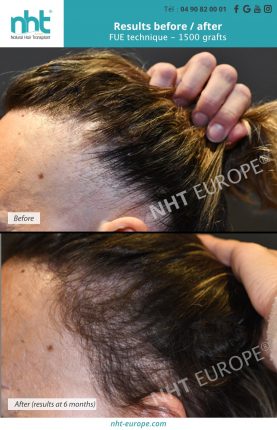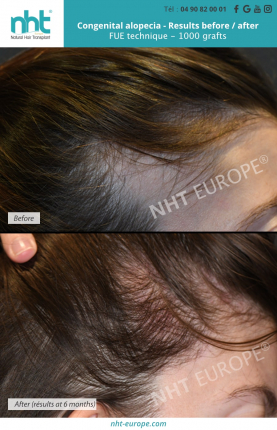Alopecia in women


Hair Transplants for Women
Alopecia in women has become more and more frequent, and its psychological impact is much greater than in men.
Fortunately, however, the treatment methods available to us have improved considerably. In these few lines, we will discuss the specific characteristics of alopecia in women.
First of all, alopecia in women can have multiple causes.
These include mineral or vitamin deficiencies, hormonal disorders (particularly in connection with the menopause, where androgenetic alopecia can develop), but also dermatological diseases with inflammatory skin disorders that can cause hair loss.
What is female androgenetic alopecia?
Androgenetic alopecia remains the most common condition, but what does it look like?
Hair growth slows down, then stops and becomes thinner. Hair becomes increasingly thin, with the scalp becoming more visible.
In women, this alopecia is more likely to affect the top of the head, around the midline.
What is your stage of alopecia?
At the very beginning, it is marked by a relatively narrow band, which gradually widens.
There is a Ludwig's classification scale, which describes this development. This widening of the midline of the scalp has been classified according to Ludwig's classification into three stages, from one to three, according to the increasing width of the thinning area.
Below is a summary table

- It starts with diffuse alopecia which begins in the parting area, in the form of a slight thinning of the hair, the anterior frontal line remains intact.
- A thinning of the hair around the centre parting follows. Hair loss is more marked on the top of the head.
- In the final stage, there is hardly any hair left on the centre parting area, alopecia has developed over most of the top of the head, the anterior frontal line is minimal but persists.
However, this classification is only of relative interest. There are widespread cases that do not follow this distribution, sometimes involving the occipital area, which is not suitable for grafting, as this is the donor area.
What are the different causes of female pattern baldness / alopecia?
As in men, the causes of baldness or androgenetic alopecia in women are numerous and varied:
- A genetic predisposition to hair loss
- Autoimmune diseases
- Change in hormone levels
- Adverse effects linked to medical treatments
- Menopause
- Pregnancy
- Excessive stress
- Dieting / rapid weight loss
- Deficiency of iron, zinc, vitamins
All of these aetiological factors require a special examination, which begins with a trichoscopic examination of the scalp, in order to eliminate a dermatological disease.
In case of doubt, the slides are transmitted to other centres around the world, which give us their opinion, allowing us to confirm the diagnosis.
This technology, which has been available for two years, thanks to artificial intelligence, is a valuable aid to diagnosis, and at a lower cost.
Medical treatments
Biological tests to look for hormonal disorders, iron or vitamin deficiencies are also necessary.
A DNA analysis will allow us to better evaluate the biological mechanisms responsible for hair loss.
All these examinations allow us to set up a strategy, which will be based on several treatments. Either by applying lotions containing active ingredients, or mesotherapy sessions with growth factors with PRP (platelet rich plasma), or by stem cell injections.
In more than 75% of cases, the evolution of hair loss is stopped, with high percentages of regrowth, and sometimes, complete regrowth.
In fact, medical treatments are much more active in women than in men. In many cases, a hair transplant can be avoided in women.
Why have a hair transplant for women?
When a hair transplant is necessary, an analysis of the density of the donor area must be carried out beforehand, to measure the number of hairs available per square centimetre, in order to establish the quantity of hairs available for the transplant, and to have a coherent strategy between the needs and the possibilities of this donor area.
A particular point, especially for women, is the possibility of performing Long Hair FUE transplants, in other words, an FUE transplant without any shaving of the hair, regardless of the length of the hair.
This makes it possible to avoid the psychological trauma of shaving the head, which is more easily accepted in men than in women, and therefore to offer these transplants more easily. This technique is nevertheless very delicate, requires specific equipment, and above all a great deal of experience with the FUE (Follicular unit extraction) hair transplant method.
Few centres in Europe offer it. We can transplant up to 2500 grafts in one session.
Robotic FUE grafting, thanks to the Artas ix robot, is not a good choice for women, because of the thinness of their hair and the softer nature of their scalp.
Therefore, hair transplants using the long hair procedure are strongly recommended for women.
All medical treatments are generally more effective for women than for men.


Long Hair FUE technique without shaving


Before and results 1 year later
How does the first consultation session for a hair transplant for women take place?
At NHT Europe, we make it a point of pride to receive each of our patients in a calm, warm and friendly atmosphere.
We strive to carry out this first consultation session because it is essential for the smooth running of the hair transplant treatment.
Indeed, during this first session, the goal is for you to tell us your expectations, your desires, your needs but also that you ask us about your doubts, your complexes and your questions.
We also use this session to gather as much information as possible:
- family genetic investigation
- possible medical treatments
- trichoscopic examination to eliminate dermatological disease on the scalp
- biological check-up to verify the absence of deficiencies
- Possibly a salivary DNA sample
It is only with the results of all these examinations that we can propose a coherent and realistic project.
We also use this session to inform you about the different medical or surgical techniques and solutions that we offer within our NHT Europe centre.
Next, we take a detailed look at the degree of your baldness, the flexibility and quality of the scalp, the possible presence of an inflammatory condition, hair density, the texture of your hair, etc. The aim is also to examine, depending on the case, the donor area (sampling area) as well as the recipient area (implantation area).

Trichoscopic scalp examination
We will also work out your treatment plan together.
You will see that during this first consultation session, we will work together to find the most suitable treatment plan. We do not influence any of our patients and take into account everything that is crucial to us in a hair transplant. We may be able to recommend against a hair transplant depending on the results of your medical examinations.
What treatments do we offer in our clinic?
We offer several treatments which can be either medical or surgical.
Among our surgical treatments, follicular implantation FUE (Follicular Unit Extraction) of the hair is optimal. Quick, economical and practically painless, this technique is often well known to the general public because it has many advantages, in particular the natural character of these results when it is well executed.
The FUE allows to densify the hair in a natural way and without scarring. A follicular unit (or graft) is made up of 1 to 4 hairs. The grafts are removed using micro-punches 0.6mm to 0.9mm in diameter.
The absence of scars as well as the preservation of the hair capital in the donor area are the advantages of FUE and is therefore a very preferred technique.
During the hair transplant session: the first step is to take grafts (from the donor areas) in order to reimplant them on the chosen (recipient) areas.
With the FUE technique: harvesting leaves no scars or visible traces on the patient. For women, the possibility of harvesting hair without shaving for hair of normal length (Long Hair FUE) is an advantageous option, because it does not require any shaving of the hair and therefore, there is no trace of harvesting after the surgery.
Over time, and thanks to technical and scientific developments, FUE hair transplantation has been modernized. Do not hesitate to inquire about our centre which is at the cutting edge of technology. By clicking on the following links, you can find out about our different treatments:
The NHT Europe centre also offers less invasive medical treatments that will allow you to limit your hair loss. For more information, do not hesitate to go to the following sections of our site:
- Genome analysis: DNA sampling
- PRP and nanofat grafting
- Conventional treatments
- Photobiomodulation
- Hormonal treatments
- Food supplements
The essential information
Major psychological impact of alopecia
Better response to medical treatments than in men
Interest in genome analysis, stem cell and growth factor injections
Strong interest in Long Hair FUE procedures without shaving, if transplantation is required.
The results and density observed on the images depend on the number of grafts implanted and the hair thickness.
Each result is therefore different from one patient to another. These images are in no way a guarantee of results.
Please note that the NHT center is closed from August 4 until August 24 inclusive.
An answer will therefore be provided to you by a doctor from the center as soon as it reopens.
NHT EUROPE




